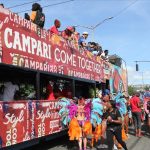
One of the highlights of flying from Montego Bay to Kingston aboard Air Jamaica’s jet service is the ability to catch a glimpse of one of Jamaica’s best treasures.
Comprising approximately 530 Square kilometres in Jamaica’s largest wilderness area, the Cock Pit Country even from that distant vantage point of the skies, is a specimen to behold. An endless grand landscape of green hillocks tightly woven together; the uninhabited natural haven is centred in the parish of Trelawny, extending to the parishes of St Elizabeth and St James.
The viewpoint from the skies though appreciated will never match up to an up close and personal encounter with this vast countryside.
No roads trespass this area, only a few footpaths skirt the perimeter of wet limestone rainforest, a karst topography that over eons have been eroded by rainfall leaving behind a unique mix of conical hills divided by steep ravines. This all fits together like a puzzle sprawling over 5000 cock pits on a dazzling terrain likened to a inverted egg carton.
The area is more than rolling hills as it is also riddled with caves, underground rivers and waterfalls. An ecological expose’, the beauty of the Cockpit Country is in its endemic plants and animals. There are over 500 species of fern, 79 species of birds, 100 endemic species of tree plants, 16 species of amphibians and 22 species of reptile found only on these lands, some being observed exclusively on a single hillock. Making this not only Jamaica’s most important refuge but an area under study by those who are attracted to the tropics, as much is still to be discovered.
A Delightful History…
The history of the Cockpit Country is decorated with the life and times of the Taino Indians and later the runaway slave “Maroons”, who were able to use the caves and the rugged terrain to aid their security concerns, gaining tactical advantage as they fought the British tyrants in the 18th century.
The south-east corridor of the Cockpit Country is often called “Look Behind”, this we are told is where the British “red coat” soldiers would ride their horses in pairs combing the vines and shrubs in pursuit of Maroons.
The Maroons would however to the surprise of their bounty hunters, use secret trails of the caves to appear and disappear at will, thwarting the English man hunt into disarray.
The Maroons would continue to live and traverse this area for much of the British rule.
Later liberated slaves settled in the area, establishing some of Jamaica’s first free villages.
Since 1996, the Southern Trelawny Environmental Agency (STEA) headquartered in Albert Town on the eastern boundary of Trelawny was established. This was out of a micro-community initiative to stimulate interests and awareness for the ecological benefits/hazards that are impacting the area while ensuring that it was recognised as a protected wild reserve.
With a small staff of 12, it functions as a very adept and involved agency following its mission clearly and sharply. A mission that includes initiating sustainable environmental programs, which look at the alternatives to the destructive practice of burning charcoal.
The harvesting of lumber, mining, hunting and trapping of wildlife is also under the microscope.
To effectively carry out this mission, the STEA is supported by the Environmental Foundation of Jamaica (EFJ) and Canada Green Fund that involves training of farmers in vegetative soil conservation.
No where looks like it…No where feels like it… No Place on earth.
For you my friends, who just can’t wait to experience this unexplored, unexploited gem of a natural reserve, The STEA has now taken on the responsibility of marketing and managing hiking, caving and heritage tours of the area. These tours are scheduled by the agency and led by experienced locals whom have been trained and certified in First Aid and CPR techniques by Government agencies. Funding for the tour guides training program was provided by the Royal Netherlands Embassy.
The Tour is equipped with caving tools and camping gear, ropes, ladders, lanterns, helmets etc. These tours are popular with European visitors and overseas students in particular, but I am sure our American, Canadian, Asian, Pacific Islanders and African brethrens from near off and far away are catching on.
Hotels in the area have welcomed the tour as an added treat to the Jamaican destination.
A bed and breakfast package is available for those who would like to experience it all, allowing visitors to hang out with the locals, who offer their homes to visitors as a very inexpensive lodging accommodation alternative. Facilities range from the rustic board houses to the elegant modern. Guest will enjoy traditional rural Jamaican hospitality, an early morning fresh cup of mint tea from the organic herbal garden, followed by a pot of steamed fish, boiled green bananas, roast yam, all served on a calabash plate.
To minimize the impact of mass tourism, groups generally are small, focusing on recreation and study, primarily.
So Come to Jamaica this winter season 2002 and feel all right frolicking in a flower field of endemic plants. Who knows, you may become one lucky person by catching a glimpse of the second largest butterfly in the world, the elusive Giant Swallowtail butterfly. It’s a natural escape that I am sure will leave you feeling all right…






